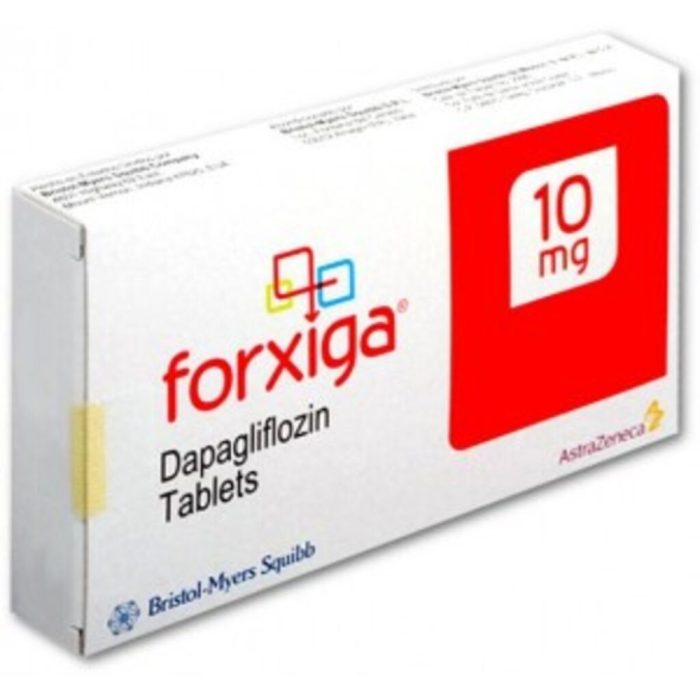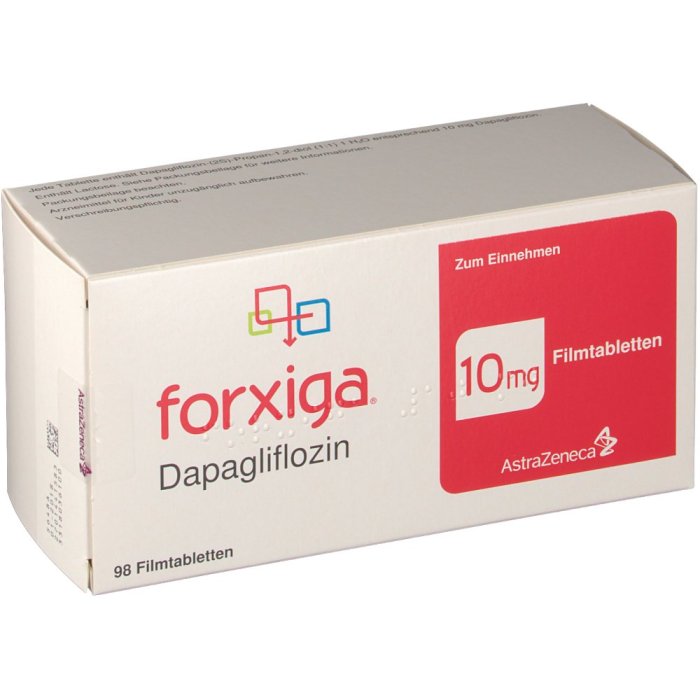Forxiga 10 mg, a medication belonging to the sodium-glucose cotransporter 2 (SGLT2) inhibitor class, has emerged as a valuable treatment option for individuals with type 2 diabetes and heart failure. This comprehensive guide will delve into the intricacies of Forxiga, exploring its mechanism of action, therapeutic indications, dosage, safety profile, and clinical significance.
We will examine the key clinical trials that have established the efficacy of Forxiga in managing blood sugar levels and improving cardiovascular outcomes. Additionally, we will address common concerns regarding adverse effects, drug interactions, and patient education. By providing a clear and concise overview, this guide aims to empower patients and healthcare professionals with a comprehensive understanding of Forxiga 10 mg.
Future Directions and Research

Forxiga, a SGLT2 inhibitor, has shown promising results in managing type 2 diabetes and cardiovascular disease. Ongoing research aims to further explore its potential benefits and address potential concerns.
New Indications and Formulations
The research into Forxiga is ongoing, and several studies are exploring its potential in new indications and formulations. For example, studies are investigating the use of Forxiga in treating chronic kidney disease, heart failure, and even non-alcoholic fatty liver disease (NAFLD).
Additionally, researchers are exploring the potential of different formulations, such as a once-weekly or long-acting version of Forxiga, to improve patient adherence and simplify treatment regimens.
Combination Therapies
Combining Forxiga with other medications or therapies has the potential to enhance its effectiveness in managing type 2 diabetes and cardiovascular disease. For example, studies have shown that combining Forxiga with metformin, a common diabetes medication, can lead to better glycemic control.
Researchers are also investigating the potential of combining Forxiga with other SGLT2 inhibitors, GLP-1 receptor agonists, or other diabetes medications to achieve synergistic effects.
Safety and Long-Term Effects
While Forxiga has been generally well-tolerated, ongoing research continues to monitor for potential long-term effects or safety concerns.
For example, some studies have suggested a possible association between Forxiga and an increased risk of lower limb amputations, especially in patients with peripheral artery disease. However, further research is needed to confirm this association and determine the underlying mechanisms.
Other areas of ongoing investigation include the potential impact of Forxiga on bone health, electrolyte imbalances, and the risk of diabetic ketoacidosis.
Comparison with Other Medications: Forxiga 10 Mg

Forxiga (dapagliflozin) is a SGLT2 inhibitor that has emerged as a valuable treatment option for type 2 diabetes and heart failure. It’s crucial to understand how Forxiga compares to other medications used in these conditions to make informed treatment decisions. This section will compare Forxiga with other commonly used medications in terms of their mechanism of action, efficacy, safety profile, and cost.
Comparison of Medications for Type 2 Diabetes, Forxiga 10 mg
The following table compares Forxiga with other commonly used medications for type 2 diabetes:
| Medication | Class | Mechanism of Action | Efficacy | Safety Profile | Cost |
|---|---|---|---|---|---|
| Forxiga (dapagliflozin) | SGLT2 inhibitor | Inhibits reabsorption of glucose in the kidneys, increasing glucose excretion in urine | Reduces HbA1c levels, lowers blood pressure, and reduces cardiovascular risk | Risk of urinary tract infections, genital yeast infections, and diabetic ketoacidosis | Moderate |
| Metformin | Biguanide | Reduces hepatic glucose production, increases insulin sensitivity, and improves glucose uptake by tissues | Reduces HbA1c levels and improves blood glucose control | Gastrointestinal side effects (nausea, vomiting, diarrhea), lactic acidosis (rare) | Low |
| Sulfonylureas (e.g., glipizide, glyburide) | Sulfonylurea | Stimulate insulin release from the pancreas | Reduces HbA1c levels and improves blood glucose control | Hypoglycemia, weight gain, potential for drug interactions | Low |
| Thiazolidinediones (e.g., pioglitazone, rosiglitazone) | Thiazolidinedione | Improve insulin sensitivity in tissues | Reduces HbA1c levels and improves blood glucose control | Fluid retention, weight gain, increased risk of heart failure | Moderate |
| DPP-4 inhibitors (e.g., sitagliptin, saxagliptin) | DPP-4 inhibitor | Inhibit the breakdown of incretin hormones, enhancing insulin release and reducing glucagon secretion | Reduces HbA1c levels and improves blood glucose control | Generally well-tolerated, but may cause mild gastrointestinal side effects | Moderate |
Comparison of Medications for Heart Failure
The following table compares Forxiga with other commonly used medications for heart failure:
| Medication | Class | Mechanism of Action | Efficacy | Safety Profile | Cost |
|---|---|---|---|---|---|
| Forxiga (dapagliflozin) | SGLT2 inhibitor | Reduces blood pressure, improves kidney function, and reduces cardiovascular risk | Reduces hospitalizations for heart failure, improves symptoms, and reduces mortality | Risk of urinary tract infections, genital yeast infections, and diabetic ketoacidosis | Moderate |
| ACE inhibitors (e.g., lisinopril, ramipril) | ACE inhibitor | Block the conversion of angiotensin I to angiotensin II, reducing vasoconstriction and aldosterone release | Reduces blood pressure, improves symptoms of heart failure, and reduces mortality | Cough, hypotension, hyperkalemia | Low |
| ARBs (e.g., losartan, valsartan) | Angiotensin II receptor blocker | Block the binding of angiotensin II to its receptors, reducing vasoconstriction and aldosterone release | Reduces blood pressure, improves symptoms of heart failure, and reduces mortality | Generally well-tolerated, but may cause hypotension | Moderate |
| Beta-blockers (e.g., metoprolol, carvedilol) | Beta-blocker | Block the effects of adrenaline and noradrenaline on the heart, reducing heart rate and contractility | Reduces blood pressure, improves symptoms of heart failure, and reduces mortality | Bradycardia, fatigue, bronchospasm | Low |
| Digoxin | Cardiac glycoside | Increases the force of heart contractions and slows heart rate | Improves symptoms of heart failure | Cardiac arrhythmias, gastrointestinal side effects, toxicity | Low |
In conclusion, Forxiga 10 mg represents a significant advancement in the treatment of type 2 diabetes and heart failure. Its unique mechanism of action, demonstrated efficacy in clinical trials, and favorable safety profile make it a valuable therapeutic option. By understanding the intricacies of Forxiga, patients and healthcare providers can work collaboratively to optimize treatment outcomes and improve overall health.
Forxiga 10 mg is a medication used to manage type 2 diabetes. It works by blocking the reabsorption of glucose in the kidneys, helping to lower blood sugar levels. While Forxiga focuses on glucose regulation, it’s important to remember that managing cholesterol is also crucial for overall health. For individuals seeking cholesterol management, vytorin might be a helpful option.
Returning to Forxiga 10 mg, it’s crucial to consult with a healthcare professional to determine if it’s the right treatment for your specific needs.